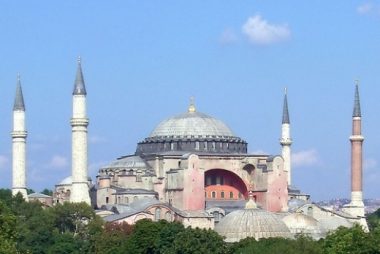By the 6th Century the Eastern Roman Empire had fully transformed itself into the Byzantine Empire. Justinian, the last emperor to use Latin, ruled until 565, leaving an impressive list of achievements that included the codification of old Roman law, the construction of Hagia Sophia, and a vigorous attempt to reclaim lost imperial lands in the west. The long reign of Justinian resulted in attempts to recover lost western provinces from barbarian control, the codification of Roman law, & construction of Hagia Sophia.
Codification of Roman law
Work on Justinian’s Codex began in 528. As with all of his visionary and ambitious projects, Justinian assembled jurists to compile the old law, known as the jus vetus, and the new law called the jus novum. The eventual Digest was comprised of fifty books, and augmented by the Institutes, a summary that could also serve as a legal text. Roman law contained the elements of due process and asserted that even emperors derived their powers from the people. These important principles would revolutionize western European legal studies in the late 11th and early 12th Centuries as relationships with the East, largely due to the period of the Crusades, reintroduced basic legal concepts. The development of a legal tradition in Western Europe was heavily influenced by the Codex Justinianus.
Construction of Hagia Sophia
The “House of Wisdom,” which became one of the largest cathedrals in Christendom, was a testament to Justinian’s support of the Orthodox Church. Massive and imposing, the cathedral was constructed over the remains of previous Christian churches, the first dating back to the earliest days of Constantinople. Perhaps symbolically, Justinian ordered the transport of the great columns of the Temple of Artemis at Ephesus to Constantinople where they figure prominently in his “Great Church.”
Expansion of the Empire and Recovery in the West



Although Justinian never personally led armies into battle, his attempts to recover lost Roman lands in the west were successfully carried out by superb generals like Belisarius. Defeating the Vandals in North Africa decisively, Belisarius reclaimed Sicily and advanced on Italy, capturing Rome and defeating the barbarian Ostrogoths.
In 541, however, the Byzantine Empire was threatened by Persian invasion and Belisarius was reassigned to protect the eastern frontiers. In Italy, Byzantine armies continued to fight the Ostrogoths for over a decade and the land was ravaged by the effects of war. According to historians Brian Tierney and Sydney Painter, “This period…marks the end of ancient Rome as one of the great metropolises of the Mediterranean world.”
The recovered provinces were swiftly lost. Manpower losses could not be replenished even as epidemics of bubonic plague ravaged the region. Belisarius eventually lost favor and was blinded, condemned to spend the rest of his life as a beggar on the streets of Constantinople.
Justinian’s Legacy
Justinian, according to historians, was a “transitional figure.” As a ruler, he is lauded and criticized for being too ambitious and overextending his resources. Yet his long reign contributed to the lasting influence of classical culture as well as forming Constantinople and Byzantine commercial interests and culture into an enduring entity lasting until 1453.
Sources:
- Cyril Mango, The Oxford History of Byzantium (Oxford University Press, 2002)
- Brian Tierney and Sidney Painter, Western Europe in the Middle Ages 300-1475 5th Edition (McGraw-Hill, Inc., 1992)
